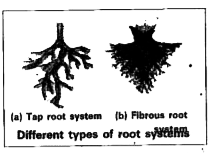Define root. Mention the types of root systems. Explain how root is modified to perform different functions. Solution in Telugu
The Radicle of the embryo elongates leads to the formation of primary roo which grows into the soil is called root. In Angiosperms, two types of root systems are present namely.
(a) Tap root system (b) Fibrous root system.
a) Tap root system : The primary root grows into the soil called tap root, which produce lateral roots and root lets constitutes tap root system. It is seen in Dicotyledonous plants.
b) Fibrous root system : The primary root is short lived and is replaced by a large number of roots which orginate from the base of the stem constitutes fibrous root system. It is seen in Monocotyledonous plants.
Root Modifications : In some plants roots chane their shape and structure to perform functions other than absorption and conduction of water and Minerals called root modifications. They are of different types.
1) Storage roots : In Carrot, turnip (Tap roots), Sweat potato (Adventitious roots), Asparagus (Fibrous roots) become swollen due to storage of food called storage roots.
2) Prop roots : In Banyan tree, Roots arise from the branches grow into the soil, become pillar. like and give additional support called prop roots or pillar roots.
3) Stilt roots : In Maize, sugarcane, roots arise from the lower nodes of the stem, give additional support called stilt roots.
4) Respriratory roots : In Mangroves like Rhizophora and Avicennia, Many roots come out of the ground and grow vertically upwards, help in respiration called Pneumatophores.
5) Epiphytic roots : In Epiphytes like Vanda, special adventitous roots arise, help is absorption of moisture from atmosphere called Velamen roots.
6) Parasitic roots : In partial parasites like viscum and strga, some Haustorial roots enter into xylem of the host plant to get water and Minerals. In complete parasitic like cuscuta and Rafflesia, the haustorial roots enter into xylem and phloem of the host plant and obtain water and Minerals and food materials called Parasitic roots.
7) Nodular roots : In the members of Fabaceae, the roots are inhabited by Rhizobium bacteria which helps in N2 fixation called Nodular roots.
8) Photosynthetic roots : In some plants like Taeniophyllum, the roots are chlorophyllous and perform photosynthesis so called photosynthetic roots.



Topper's Solved these Questions
- MORPHOLOGY OF FLOWERING PLANTS BOOK - VIKRAM PUBLICATION ( ANDHRA PUBLICATION)CHAPTER - MORPHOLOGY OF FLOWERING PLANTS EXERCISE - TEXTUAL EXERCISES
15 Videos
- MORPHOLOGY OF FLOWERING PLANTS BOOK - VIKRAM PUBLICATION ( ANDHRA PUBLICATION)CHAPTER - MORPHOLOGY OF FLOWERING PLANTS EXERCISE - SHORT ANSWER TYPE QUESTIONS
10 Videos
- MODES OF REPRODUCTION BOOK - VIKRAM PUBLICATION ( ANDHRA PUBLICATION)CHAPTER - MODES OF REPRODUCTION EXERCISE - TEXTUAL EXERCISES
11 Videos
- PERIPLANETA AMERICANA (COCKROACH)BOOK - VIKRAM PUBLICATION ( ANDHRA PUBLICATION)CHAPTER - PERIPLANETA AMERICANA (COCKROACH)EXERCISE - IMPORTANT QUESTIONS
15 Videos
Similar Questions
In which plant, the underground stem grows horizontally in soil and helps in perennation?
View SolutionExplain different regions of root with neat labelled diagram.

View SolutionWhy is reproduction essential for organisms?
View SolutionHead of cockroach is hypognathous beccause
View SolutionRoots are modified to perform additional func- tions. Explain with examples.
View Solution$ Photosynthesis roots are a type of Tap Root System.
! Anoxygenic photosynthesi is performed by photosynthetic roots.
View SolutionDefine root. Write briefly the types of root system.
View SolutionWhy do roots modify their structure ? Name the types of root modification.
View SolutionWhy do roots modify their structure ? Name the types of root modification.
View SolutionRoots are modified to perform physiological function in
View SolutionHow is adventitious root system different from fibrous root system.
View Solutionplant morphology- introduction, plant types: root- basic characters, primary functions tap root systems and advent root system
View SolutionIntroduction root system ||General characters and functions OF root system|| Types OF Root System
View SolutionExplain different types of Root-Systems with examples and write the functions of roots.
View SolutionDefine modification. Mention how root is modified in Banyan tree and mangrove plants.
View Solution
